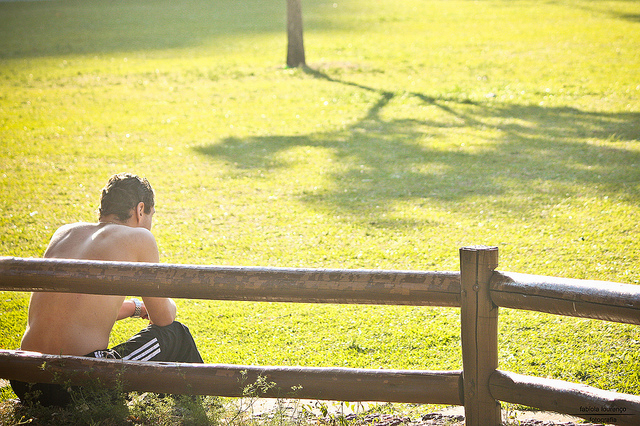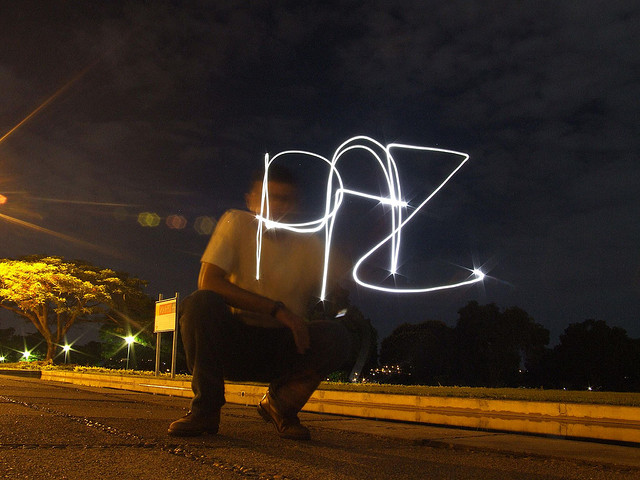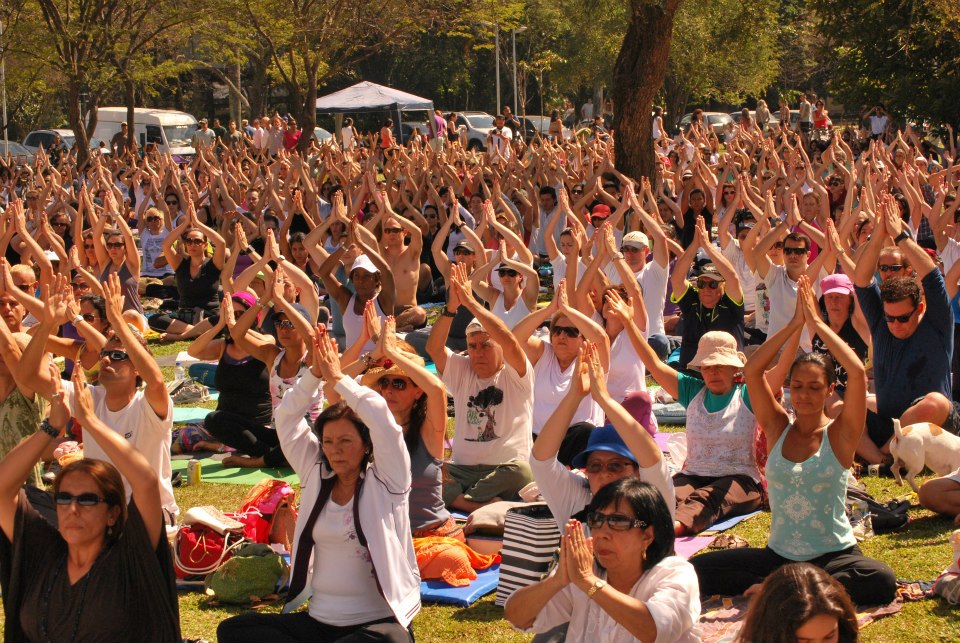Brazil is 83rd among 158 ranked nations in 2012's edition of the Global Peace Index (GPI), having fallen nine places since last year's. The report points out [pt] that, in general, the world has become more peaceful for the second year in a row, with the exception of the Middle East and North Africa region.
Natasha Romanzoti [pt] explains the reasons for Brazil's position in the middle of the ranking:
Historicamente, não nos envolvemos em muitas guerras, porém nossa violência interna é suficiente para não deixar o país subir muito no Índice. […]
O IGP de 2012 mostra que os pontos em que somos menos pacíficos são, em indicadores em ordem decrescente: homicídios, crimes violentos e terror político, acesso a armas, e violência percebida pela sociedade.
Alguns dos pontos em somos mais pacíficos são, empatados: conflito organizado, atos terroristas, mortes por conflito interno e por conflito externo, armas pesadas e relações com países vizinhos
Historically, we haven't got involved in many wars, however our internal violence is enough not to let the country climb up the index. […]
2012's GPI shows that the matters we're less peaceful at are, in indicators in descending order: homicides, violent crimes and political terror, access to weapons, and violence perceived by society.
Some of the matters we are more peaceful at are, tied: organized conflict, terrorist acts, deaths by internal conflict and by external conflict, heavy weaponry and relations with neighbouring countries.
Perhaps Brazil will have its position improved next year, following the National Disarmament Campaign [pt] which has already collected over 57,000 weapons [pt] across the country. Launched a year ago with the slogan “Take a weapon out of the future of Brazil,” the campaign uses Twitter, Facebook, YouTube and other social networks to spread the message.
While disarmament is a controversial subject among adults, a new generation of children are learning early on the importance of peace through the parallel campaign of “child disarmament” which collects toy guns and turns them into recycled plastic. The Diarinho Blog reports [pt]:
Quem descobre desde a infância que arma – mesmo falsa – não é legal vai preferir ficar sempre bem distante dela. E isso pode impedir que muitas tragédias aconteçam. Ainda ocorrem casos de meninos e meninas que encontram por acaso armas de verdade em casa e, por curiosidade e falta de informação, machucam alguém ou a si mesmos. Em casos mais graves, podem até morrer ou matar sem querer.
The ones who find out since childhood that a weapon – even a false one – is not cool [Translator's note: the original word in Portuguese, ‘legal’, may have two meanings, either cool or legal] will prefer to always keep a distance. And that may prevent many tragedies from taking place. There are still cases of boys and girls who find real weapons at home by chance, and for curiosity and lack of information, they hurt someone or themselves. In more serious cases, they can even die or kill without meaning.
Many other initiatives are emerging within the population itself, as the Yoga Pela Paz [pt] (Yoga for Peace) movement, which promoted in August more than 500 free classes that have benefited thousands of people in cities across the country.
Marcia De Luca, founder, explains that the idea was born of a “dream of working for a better world”, with some inspiration from Ayurveda, an ancient Indian healing system that defends the practice of “therapy of opposites” to create balance in life:
Assim, em um mundo de violência, movimento e stress, temos que acionar o contrário: paz, aquietamento e calma. É a forma de contrabalançar o que há em excesso no momento atual e melhorar nossa existência.
Praticar yoga e meditação e seguir uma rotina diária de aquietamento e paz são a proposta maior do Yoga pela Paz. Vivenciar o momento presente é também nosso foco, pois assim conseguimos minimizar a “tagarelice” da mente e começamos a observar o que acontece à nossa volta com maior atenção.
[…]
Muita gente se pergunta: mas será que eu posso mesmo mudar o mundo? A resposta é não e sim. Não podemos mudar o mundo em si, mas podemos mudar o mundo através da nossa mudança individual. Se cada um de nós se tornar um ser humano melhor e a partir dessa mudança individual formarmos uma massa crítica de pessoas com a intenção de paz em todos os sentidos, aí sim! Juntos, podemos fazer a diferença para um mundo melhor.
Thus, in a world of violence, movement and stress, we have to activate the opposite: peace, quieting and calm. It's a way to counterbalance what is in excess at the present moment and to improve our existence.
Practicing yoga and meditation and following a daily routine of peace and quieting are the main proposals of Yoga for Peace. To experience the present moment is also our focus because that way we can minimize the “chatter” of the mind and begin to see what happens around us with more attention.
[…]
Many people ask themselves: but could it be that I can really change the world? The answer is no and yes. We can not change the world itself, but we can change the world through our individual change. If each one of us becomes a better human being and from that individual change we form a critical mass of people with the intention of peace in every way, then yes! Together we can make a difference for a better world.
Marilda Reina [pt] is inspired by slides she found on the Internet about peace and nature:
Algumas fotos registram o amor entre as espécies e, também, registram a irracionalidade do nosso semelhante. Por sorte, uma grande parcela de seres humanos estão se unindo para tornar nosso planeta um mundo mais harmônico, aprendendo e ensinando a respeitar os recursos naturais. Ainda temos muito trabalho pela frente, então vamos passar os bons exemplos adiante, vamos contagiar mais e mais pessoas com o sentimento de amor e respeito.
Some photos register the love between species and also the irrationality of our neighbor. Luckily, a large portion of humans are uniting to make our planet a more harmonious world, learning and teaching to respect natural resources. We still have much work ahead, so we'll pass the good examples below, we will infect more and more people with the feeling of love and respect.
In the eve of International Peace Day, September 21, Suzane Rodrigues [pt] explains that to find the long-sought peace not major efforts are needed:
Paz uma palavra que colocam como extinta ou de um futuro próximo. Em verdade o conceito de paz é errado, pois passaram a ideia errada. E todos consomem essa ideia. Paz é apenas ter tranquilidade e estar bem consigo, apenas isso. Não interessa se o dia está nublado ou de extremo calor, a paz está ali na sua frente basta você acordar bem e convida-la para entrar na sua mente e futuramente na sua vida. Não quer dizer que ela estará vinte quatro horas por dia nos trezentos e sessenta e cinco dias do ano, mas durante duas horas ou durante alguns minutos ela pode estar conosco, basta ela ser o suficiente para transformar o restante do dia. A paz pode ser diária.
Peace, a word which they pose as extinct or referring to the near future. In fact the concept of peace is wrong because the wrong idea was passed on. And all consume that idea. Peace is just having tranquillity and being good about oneself, just that. No matter if the day is cloudy or extremely hot, peace is there in front of you, you just have to wake up well and invite her [peace] to come into your mind and in the future into your life. It doesn't mean that she will be there twenty four seven, for three hundred and sixty-five days of the year, but for a couple of hours or for a few minutes she can be with us, she can just be enough to turn the remainder of the day. Peace can be daily.

“Da quietude” (On stillness), photo by Fabíola Lourenço, published on Flickr under a Creative Commons license (CC BY-NC-ND 2.0)
And finalizes:
O mundo pode ter paz se deixarmos nossa mente aberta à novas respostas, não pensar que para ter paz precisamos de pessoas melhores, porque você é o mundo, logo, a paz depende de você e não das pessoas. Eu faço a minha paz e você faz a sua. E assim teremos uma sociedade em paz, porque o mundo individual se encontra em paz. Vivemos em conjunto, mas não somos o conjunto, somos uma parte desse conjunto e para o conjunto estar em paz, toda sua parte precisa estar. Falando sério, isso é muito difícil pois a paz do outro não depende de você, como sua paz também não depende dele. E estar em sintonia não é fácil quando falamos de seres humanos.
The world can have peace if we let our minds open to new answers, not to think that to have peace we need better people, because you are the world, so peace depends on you and not on the people. I make my peace and you make yours. And so we have a society at peace, because the individual world is at peace. We live together but we are not the whole, we are a part of that whole and for the whole to be at peace, each part of it must be. Seriously, this is very difficult because the other's peace does not depend on you, like your peace doesn't depend on him. And being in tune is not easy when it comes to humans.








